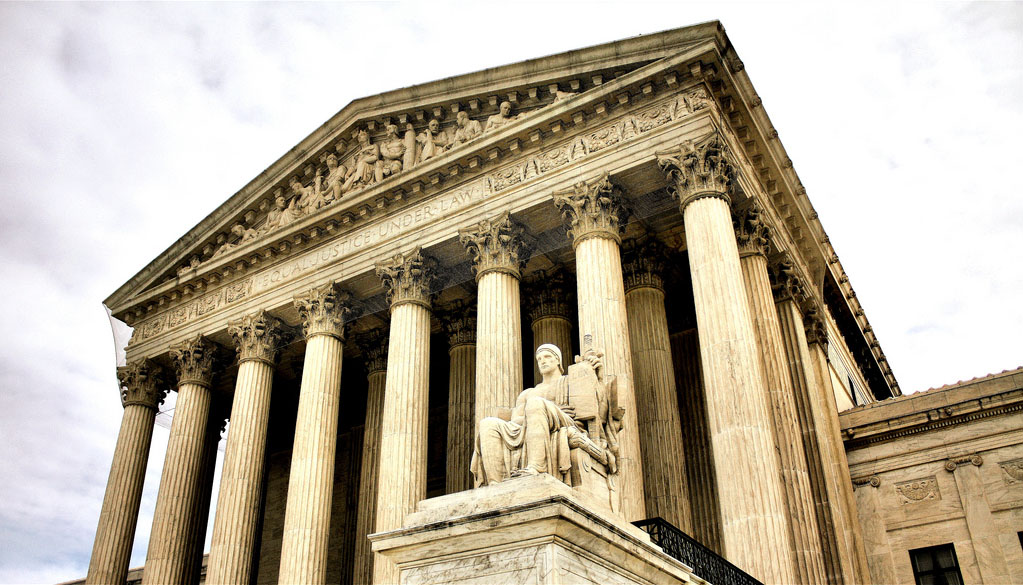Impartiality and equality in the eyes of the law are the cornerstones of the American justice system. In fact, when Cass Gilbert designed the Supreme Court Building in Washington D.C. he etched “Equal Justice Under Law” into the western façade of the building, highlighting the importance of this guiding principle[i]. Ensuring the impartiality of judges is a key aspect of safeguarding this important American ideal.
Recent cases in which Supreme Court justices have refused to recuse themselves when a bias was perceived has led some legal scholars to question the extent to which equality exists in our nation’s highest court[ii]. Under the current judicial disqualification system, when there may be a conflict of interest, it is up to the individual justices to determine their ability to hear a case without prejudice[iii]. By human nature, the justices are likely to give themselves the benefit of the doubt and hear the case. In order to create a more perfect system and move us closer to our guiding principles, Congress must implement a system for judicial disqualification for the Supreme Court that removes the justice in question from the decision making process.
The Supreme Court itself has determined that there is a problem with allowing judges to determine whether or not they should recuse themselves. In Caperton v. A. T. Massey Coal Co. the Court determined that the failure of West Virginia Supreme Court Justice Brent Benjamin to recuse himself constituted an error in due process[iv]. Justice Benjamin had been elected to the West Virginia Supreme Court due to the support of an executive that worked for one of the litigants, A. T. Massey Coal Co[v]. The executive had been thoroughly involved in the campaign and provided a significant amount of the funding[vi]. Despite his obvious and egregious conflict of interest, Justice Benjamin refused to remove himself from the case[vii]. Though the US Supreme Court found Justice Benjamin’s conduct created an error in due process, they could not agree upon a set of objective standards for recusal[viii]. With the diverse legal opinions that exist on the court, it is unlikely five Justices would ever be able to agree on such a standard. Congress is going to have to act if the judicial disqualification process is to be reformed.
Congress has attempted to implement such a reform in the past. They passed 28 U.S.C. 455(a) which states, “Any justice, judge, or magistrate judge of the United States shall disqualify himself in any proceeding in which his impartiality might reasonably be questioned.”[ix] This law set the subjective standard that exists today. Though the ‘objective observer’ standard rests on good principle, it fails to take the determination of impartiality out of the hands of the individual Justices. The weakness of this measure was demonstrated by Supreme Court Justice Antonin Scalia when he denied a recusal request in Cheney v. United States District Court for the District of Columbia. While the case was pending, Scalia went on a hunting trip with Vice President Cheney. Scalia flew down on the Vice President’s jet, ate meals with the Vice President, and was even in the same hunting party[x]. The abundance of opportunities for ex-parte communication led many observers of the court to question Scalia’s ability to hear the case without prejudice[xi]. Scalia denied a motion that would have removed him from the case despite public outrage[xii]. Scalia demonstrated the weakness of 28 U.S.C. 455(a) and the need for a new system to be put into place.
One way Congress can achieve this goal is to pass Rep. Chris Murphy’s judicial transparency bill. Rep. Murphy developed the bill after learning about secretive special interest conferences that were attended by Supreme Court Justices[xiii]. The bill would require the Supreme Court to develop a system that gives litigants the ability to request a ruling from the entire Court or a panel of the Court on potential conflicts of interest of individual justices[xiv]. The primary benefit of this system is that it removes the Justice from determining their own impartiality but the decision remains in the Supreme Court, ensuring separation of powers and the independence of the Judiciary branch is protected.
Another way opportunity for reformed would be to establish objective standards for Supreme Court recusal. This can be easily accomplished by Congress if they extend the ethics rules that currently apply to US circuit and district Judges to the Supreme Court justices. These rules are codified in the Judicial Conference’s Code of Conduct for United States Judges[xv]. They provide guidance for federal judges on how to conduct themselves in a legal and ethical manner[xvi]. There are even clauses in the code which describe situations in which Judges must recuse themselves[xvii]. Since the laws are clear and specific, the law has already determined the decision of eligibility. Though there is still some room for interpretation, the majority of conflict of interest motions can be decided through a clear reading of the law. If these rules were applied to the Supreme Court, the Justices would not be able to so easily dismiss their conflicts of interest.
Those who argue against recusal reform for the Supreme Court contest that any measure put into place would dramatically increase the amount of recusals, crippling the Court’s ability to function as intended. Since there are only nine Judges in the world that are eligible to hear cases in the Supreme Court, a recusal means that a vote is absent and the decision is left to the remaining eight Justices. Though a significant increase in recusals would undoubtedly alter the dynamics of the Court, an increase of this magnitude is unlikely given the current Justices’ attitudes towards recusal[xviii]. Also, only one percent of Supreme Court cases over the past eighteen years have resulted in a divided Court due to a Justice’s recusal[xix]. Even if the Court were to be deadlocked, the decision of the lower court stands so Justice is still served. An impartial decision from a Circuit Court would better serve Justice than a tainted decision from the Supreme Court.
A recent poll showed that only 32 percent of Americans have confidence in the Justice system[xx]. This decline can be traced back to recent highly publicized cases in which Supreme Court justices refused to recuse themselves despite perceived conflicts of interest. The American people are fearful that we are moving away from “Equal Justice Under Law” instead of towards it. To reverse this trend, Congress should pass Rep. Murphy’s bill or extend existing ethics laws to apply to Supreme Court Justices. In order to revitalize the integrity of the Supreme Court Congress must act to install reforms that remove Justices whose impartiality has been called into question.
[i] “US Supreme Court,” National Register of Historic Places, accessed March 16, 2011, http://www.nps.gov/nr/travel/wash/dc78.html.
[ii] Roger J. Miner, “Judicial Ethics in the Twenty-First Century: Tracing the Trends,” Hofstra Law Review 32 (Summer 2004): 1107.
[iii] Michael D. Crim and Jeff Van Volkenburg, “Defense Counsel Journal,” Professional Liability Committee Newsletter 77, no. 2 (April 2010): 254.
[iv] Michael D. Crim and Jeff Van Volkenburg, “Defense Counsel Journal,” Professional Liability Committee Newsletter 77, no. 2 (April 2010): 254.
[v] Harvard, “Caperton v. A.T. Massey Coal Co.: due process limitations on the appearance of judicial bias,” Harvard Law Review 123, no. 1 (November 2009): 73.
[vi] Harvard, 73.
[vii] Crim, 256.
[viii] Miner, 1119.
[ix] Monroe H. Freedman, “Duck-Blind Justice: Justice Scalia’s Memorandum in the Cheney Case,” Georgetown Journal of Legal Ethics 18, no. 229 (Fall-Winter 2004): 230.
[x] Richard B. Cheney, Vice President of the United States v. United States District Court for the District of Columbia, No. 03-475 (March 18, 2004) (LEXIS).
[xi] Freedman, 230-231.
[xii] Cheney v. US District Court
[xiii] ” Murphy Unveils Legislation to Increase Transparency and Accountability at Supreme Court,” Congressman Chris Murphy, accessed March 16, 2011, last modified March 1, 2011, http://www.chrismurphy.house.gov/index.php?option=com_content&task=view&id=484&Itemid=1.
[xiv] Rep. Chris Muphy
[xv] “Judicial Conference Code of Conduct,” United States Courts, http://www.uscourts.gov/Viewer.aspx?doc=/uscourts/RulesAndPolicies/conduct/Vol02A-Ch02.pdf.
[xvi] Judicial Conference Code of Conduct.
[xvii] Judicial Conference Code of Conduct.
[xviii] New York Times.
[xix] Jason Harrow, “How Often Does a Recusal Result in a Divided Court?” SCOTUS Blog, last modified March 6, 2008, http://www.scotusblog.com/2008/03/how-often-does-a-recusal-result-in-an-equally-divided-court/.
[xx] Miner, 1107.



